Box Jellyfish - Nature's Deadliest Creature
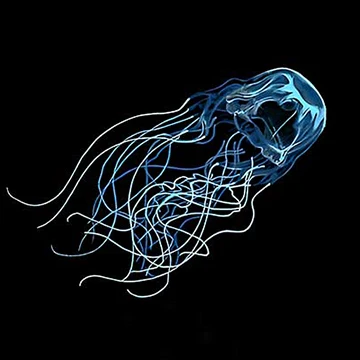
Contents
Box Jellyfish Description
The box jellyfish with its cube-shaped body and long trailing tentacles and nearly invisible and ghost-like appearance, is the most venomous creature on Earth. Its sting can kill a human in under two minutes!
• Box Jellyfish Size & Colour: An adult box jellyfish can grow to 30 cm in diameter, weigh up to 2 kg. It is slightly pale blue in colour and is almost transparent.
• Pedalium & Venomous Tentacles: The adult box jellyfish has four stalks, called pedalium, hanging from each of the lower corners of the bell. These stalks have up to 15 slender, hollow, and venomous tentacles 4.5 meters long, with deadly stinging cells called nematocysts.
• 24 Eyes: Grouped in clusters of six, these eyes are sensitive to light, odour, and orientation and contain pacemakers that regulate the expansion and contraction of the bell, controlling the jellyfish's movement.
• Speed and Agility: Using a water-jet propulsion system, the box jellyfish can swim at 7.5 km/h—faster than an Olympic swimmer!
• No Brain: Lacking a centralized brain or heart, it relies on a complex network of neurons for navigation and hunting.
• No Heart or Blood: Nutrients are transported throughout its body by diffusion from cell to cell.
• No Gills or Lungs: It absorbs oxygen and releases carbon dioxide into the water by diffusion through its skin.
• Gravity Sensors: Detecting the earth's gravitational pull, helping the animal balance and orient itself.
• Vibration Sensors: Allow it to detect prey and water turbulence.
• Sleeping: During the night, box jellyfish slowly sink to the bottom of the ocean and settle on the ocean floor to sleep.
Box Jellyfish Sting
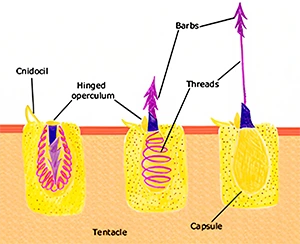
Photo: Diagram of cnidocil, nematocysts and barbs
Do box jellyfish bite? No! Box jellyfish don't bite—they sting. When triggered by the slightest touch or movement, its thread-like tentacles coil around its prey in a almost inescapable embrace. Thousands of nematocysts fire venomous barbs that pierce its victim's skin, injecting potent toxins. The the pain is excruciating and often described as feeling like being "branded with red-hot irons." In severe cases, the venom can cause cardiovascular collapse, leading to death within minutes.
The box jellyfish is not aggressive towards humans. However, they live in the same warm, shallow waters popular with swimmers and encounters are usually accidental. Australian box jellyfish have caused at least 80 deaths since 1883. The most recent box jellyfish sting death was a 14-year-old boy who died in 2022.
How to Avoid Box Jellyfish Stings
Box jellyfish do not attack humans. It is a question of being in the wrong place at the wrong time and running into one. Box jellyfish are nearly invisible, and their stings are deadly. Here are some safety tips.
• When in Doubt, Stay Out! If you're unsure about the safety of the water, it's best to avoid swimming.
• Cure for Box Jellyfish Sting. The only known remedy for a box jellyfish sting is vinegar, which neutralizes the venom and eases the pain. Swift application of CPR is critical for survival until professional help arrives.
• Interesting Fact: Did you know that box jellyfish are more likely to sting light-skinned swimmers than dark-skinned ones. This is because the jellyfish can see the higher contrast of a dark-skinned person's body in the water and may swim away.
Box Jellyfish Lives as Two Different Animals
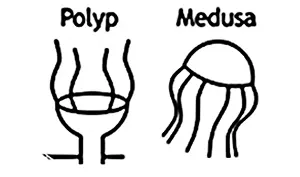
Photo: Diagram of two life stages of box jellyfish
Just like a caterpillar turning into a butterfly, has a dual existence, living as two completely different creatures during its lifetime.
• Polyp Stage (Juvenile):The life cycle of a box jellyfish begins with an egg that hatches into a planula, a flat and oval-shaped larvae that attaches itself to a solid surface. Here it transforms into a flower-like polyp. During this stationary stage, the box jellyfish feeds on crustaceans, rotifers, water insect larvae, and aquatic mites. The polyp then transforms into miniature version of adult box jellyfish detach from it surface and begins the next stage of its life as medusae.

Photo: Diagram of box jellyfish anatomy
• Medusa Stage (Adult): The adult box jellyfish's body has two tissue layers—an outer ectoderm and an inner endoderm—with a non-living mesoglea layer in between that gives it structure. A contractile ring of cells propels the jellyfish through water. The lower part of the bell curves inward to form a velarium, which opens and closes like an iris. Its mouth and stomach extend from the top of the bell to catch prey, then retract to digest it. Waste is expelled through the mouth.
Box Jellyfish Swimming (Movement)
Box Jellyfish Swimming Video
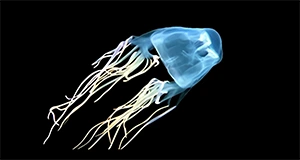
The box jellyfish is a graceful swimmer. To swim it contracts its bell and ejects water through a constricted opening in its velarium to propel itself. Using this water-jet propulsion the box jellyfish can move at speeds of up to six meters/second. That is 7.5 kilometres per hour - faster than an Olympic swimmer! It can also change direction by adjusting the rhythm and strength of the contraction of its body. This squeezing action is the pulsating motion often seen in jellyfish. Because of their superior mobility, they are rarely found washed up onshore.
Box Jellyfish Habitat

Photo: Box jellyfish habitat map
Box jellyfish are found along the north-eastern coast of Australia, particularly near the Great Barrier Reef and in the Indo-Pacific Oceans to the north. They usually inhabit shallow waters near estuaries and bays with gently-sloping beaches where they can swim without entangling their long trailing tentacles. They prefer warm, tropical waters with temperatures between 20°C and 30°C. During mating season, they can also be found in deeper waters up to 100 meters below the surface.
Box Jellyfish Diet
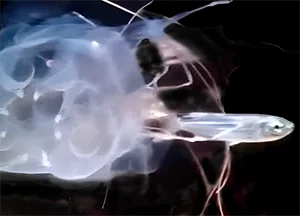
Photo: Box jellyfish consuming a fish
The box jellyfish is a deadly carnivore, feeding on small fish, crustaceans, marine larvae, plankton, and even other jellyfish—though never its own kind. Unlike most jellyfish that drift with ocean currents, the box jellyfish actively hunts its prey using its sharp eyesight and its ability pursue prey. It strikes with long, venomous tentacles that swiftly immobilize its victims. The victim is then drawn to the jellyfish’s central body, where the bell expands downward to engulf and digest the catch. Waste is later expelled through the mouth. It hunts mainly during the day when its vision is most effective.
Box Jellyfish Reproduction & Life Cycle
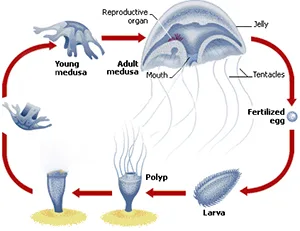
Photo: Diagram of Box jellyfish life cycle
Box jellyfish reproduce by releasing eggs and sperm into the water. This process, called spawning, generally happens once a year in estuaries where many jellyfish gather. A few days later, fertilised eggs develop into flat, oval-shaped planulae larvae. These tiny larvae drift down to the estuary floor, attach themselves to a hard surface such as an overhang or crevice, and grow into a flower-like polyp and eventually a fully grown box jellyfish.
Box Jellyfish Predators and Threats

Photo: Green turtles eat jellyfish
Despite their lethal venom, box jellyfish are not immune from predators. Several marine animals, including sea turtles, which are uniquely resistant to their venom, can consume them without harm. These include:
. Sea Turtles: Immune to their venom.
. Large Fish: Such as tuna and butter-fish feed on juvenile and smaller box jellyfish.
. Crustaceans and Sea Anemones: Which prey on their larvae.
Are Box Jellyfish Endangered
Box jellyfish are not endangered. In fact, there is anecdotal evidence to suggest that the warming of the oceans caused by global warming is providing ideal conditions for the box jellyfish to thrive in.
What is a Group of Jellyfish Called?
A group of jellyfish is known as a bloom or swarm. Box jellyfish blooms usually occur during the wet season, from about November to April. Blooms are generally a result of behavioural and ecological causes, such as an increase in water temperature or food supply.
25 Box Jellyfish Fun Facts
- The box jellyfish is the world's deadliest animal.
- It lives along the north-eastern coastline of Australia.
- The box jellyfish can grow as large as a basketball. That is 30 cm or 12in in diameter. It can weigh up-to 2kg or 2.5lbs.
- From each of the lower corners of its body hang up to 15 long, slender, hollow, and venomous tentacles.
- These can grow up to 4.5m in length.
- When these tentacles are touched, they fire tiny harpoons to paralyse its prey.
- They prey trapped in its tentacles is then hauled up and eaten.
- Its venom can kill a human in 2 minutes.
- Its venom kills by paralysing the heart in a contracted state.
- The best remedy for a sting is vinegar, CPR, and urgent medical attention.
- The box jellyfish feeds and poops from the same multifunction opening.
- It is composed of 96% water.
- The box jellyfish has 24 eyes.
- But it has no brain, gills, lungs, or heart.
- It is nearly invisible in water.
- The box jellyfish is not a jellyfish at all because it can swim (other jellyfish can't).
- It has gravity sensors to help it balance and orient itself.
- It can swim at twice the speed of humans.
- It starts off life as a polyp similar to a coral.
- It has no interest in attacking people.
- Light-skinned people are stung more often than dark-skinned people.
- A group of jellyfish is called a bloom or swarm.
- Because it can move, box jellyfish actively hunt for prey.
- In Australia, the box jellyfish has caused at least 79 deaths since 1883.
- The last death was in 2022.
Explore More About the Great Barrier Reef Animals
Looking for more information on marine creatures? Check out our guides on other fascinating and dangerous animals from the Great Barrier Reef and beyond!